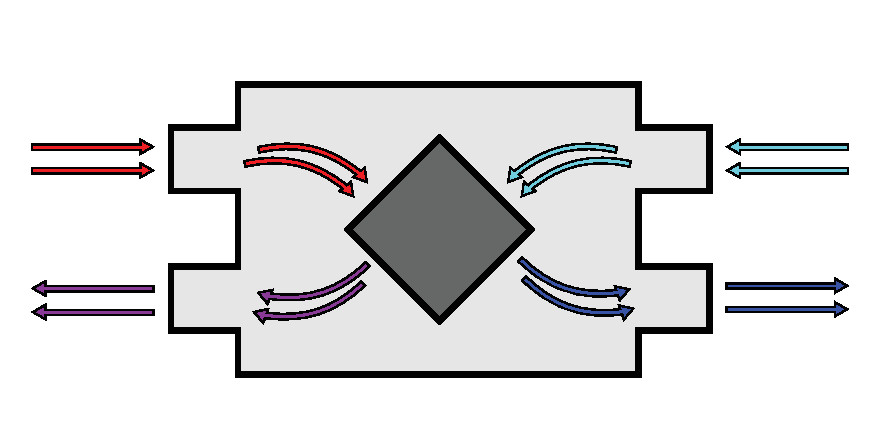Cost to Install an Energy Recovery Ventilator – 2025 Prices
Energy recovery ventilators, or air exchangers, save on energy bills by conserving energy and reducing the amount of energy needed to heat or cool fresh air brought into the home. Many homeowners wonder how much these systems cost.
2025 Energy Recovery Ventilator Costs
Calculate local project costs by entering your zip code.
Custom Location
| National Average Price | $2,000 |
| Typical Price Range | $1,500 - $2,000 |
Get free estimates from contractors near you.
On this page:
How Much Do Energy Recovery Ventilators Cost?
Tightening your home with insulation, storm doors and windows, and weather strips to conserve energy has its drawbacks. One serious drawback is that it traps stale air inside your home.
Some of that air gets vented out through exhaust fans, mainly in the kitchen, bathroom, and laundry room. But how much of that energy gets wasted when vented straight out of the home?
Energy recovery ventilators, an improved version of an air exchanger, save energy by recovering some of that energy before it leaves your home.

The national average for an energy recovery ventilator with installation is roughly $2,000. This number varies by region due to the cost of labor, the brand chosen, and whether you use an HRV (Heat Energy Recovery) or ERV (Energy Recovery Ventilator).
Adding an HRV or ERV is a great way to improve the efficiency of your HVAC system. It could be cheaper than a furnace or air conditioning replacement if the goal is to reduce the costs of operating the system.
Read on to learn more about what impacts the total price.
HRV vs. ERV
The primary difference between a Heat Energy Recovery Ventilator (HRV) and an Energy Recovery Ventilator (ERV) is the HRV processes only heat and is used in cold climates, while the ERV processes both heat and humidity and is used in hot and humid climates.
HRVs are also better for small homes with few occupants, while ERVs are best for larger homes with more occupants.
Both bring fresh air into the house or building and exhaust stale air. During this process, both devices recapture energy for reuse.
In the completed system, intake air vents usually get positioned in the living room, dining room, and bedrooms, whereas outtake vents get added to bathrooms, kitchens, and laundry rooms.
The HRV would do the same to recapture heat lost through regular range hoods and exhaust fans. Imagine how much energy would get saved when the heat from the dryer vent is recycled.
According to the Minnesota Sustainable Housing Initiative, ERVs typically cost $150 to $200 more than HRVs.
Before installation, the units often cost $1,000 to $1,900.
Which System is Right for My House?
The HRV warms the air brought in and recycles the indoor heat before venting the stale air out. Therefore, in colder areas where heat is the main concern, the HRV provides the most benefit to the homeowner.
The HRV still works during the cooling season, but because it only recovers dry air and not moist air, it is not as effective during the usual cooling period.
An ERV captures heat, cools, and dehumidifies the air coming into the house. Therefore, it is most beneficial to those in humid areas. However, the ERV can benefit both.
Most experts agree for the price difference, it is better to choose an ERV regardless of your area’s climate.
Maintenance Costs of ERV & HRV Systems
Neither of these systems requires much maintenance. The filters must be cleaned or changed quarterly, or every 90 to 120 days. People with pets or smokers in the house should consider changing the filter more frequently.
A Minimum Efficiency Reporting Value (MERV) filter usually costs between $7.00 – $20.00, depending on where you buy them. As with most retail products, the best option is to buy in bulk.
Homes typically use a rating of 7-12. Lower ratings allow fewer pollens and allergens to flow through the filter. If you change the filter every three months, that’s about $5.50 or $22.00 per year.
We suggest shopping around to get the best price before buying a big box of filters. Remember, you will change these four or five times a year, so buying a box of these is the best option.
Cost When Installing With a New Furnace or HVAC
The price of the HRV and ERV is much less when coupled with repairs, scheduled maintenance, and the installation of a new furnace or HVAC system. This is because installing new ducting for an ERV is much easier when the main ducting for the furnace is already disassembled and the technician is already working with their tools and worksite set up.
The average labor cost to install the ERV is around $250 to $400.
What is the ROI?
According to Architect Magazine, the average time to recoup your investment through reduced energy bills is three months to three years. It mostly depends on how much you spend to heat and cool your home and where you live.
These systems do save the homeowner money on utility bills. The more energy you use, the more you will save. Also, some areas offer substantial rebates and discounts for installing energy-efficient home appliances.
DIY or Professional Install
It is best to consult a professional to get the most out of an HRV or ERV. But if you have the tools and time, plus the DIY prowess, you can find several installation videos on YouTube.
Labor to install an air exchanger will vary depending on the complexity of the project, your geographic location, and the rates charged by the contractor doing the work. The average cost of installation is $800 to $1,200 if you need new ducts, but closer to $250 to $400 if you have ducts installed or have this installed with a new HVAC system.
When preparing for the project, we suggest getting several estimates to consider a range of contractors, options, and costs for the project. Check their license, insurance, and statement of work to ensure you are getting what you need.
All pricing information on this page is based on average industry costs, and is subject to variance for project-specific materials, labor rates, and requirements.


